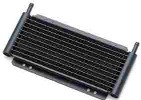

Transmission Coolers
Why do you need an external transmission cooler? Many "performance" websites these days are telling everyone it is unnecessary to run an external transmission cooler. Their reasoning for this is the assumption that external coolers are a source for leaks. If installed incorrectly and with inferior hardware, this can be true. However, none of these websites bother to state the benefits of having a transmission fluid cooler on your vehicle.
Transmission builders and aftermarket part manufacturers have known for years the benefits of maintaining "lower" transmission fluid operating temps. Automatic trans fluid temps in most cars and trucks run between 195° F and 230° F. Most aftermarket builders agree that 170° F - 180° F is preferred for the best balance of durability, consistency, and performance. You also don't want your transmission fluid temps too cold because at those lower temps, problems with consistency and lubrication can result. Of course higher temps can cause fluid breakdown and eventually transmission failure.
When do you need an external transmission fluid cooler? Well we all know that if you are doing any towing you should have one. But if you have increased the performance of your engine or installed a higher stall torque converter, it would be a good idea to have a cooler. Even when using a stock torque converter, increased engine power output will cause the stock torque converter to stall higher which heats the fluid more than normal. Most aftermarket converters stall higher which in itself, causes higher fluid temperatures due to the increased fluid sheer forces and pressures in within the torque converter.
So how do you install one on your vehicle to insure against leaks? Very Simple. First, use only the correct size and type hose for the size fittings or lines you are working with. DO NOT USE FUEL HOSE. Transmission fluid specific hose is rated for the pressure and chemical properties of transmission fluid. I also recommend using high-quality clamps, the type that use a fine-threaded bolt and nut to tighten them with. If you can not find these high-quality clamps, you can use the cheaper design screw/slotted band type clamps. MAKE SURE you check and re-tighten all clamps as the seasons change. Wild temperature swings can cause the hoses to shrink/expand which can lead to leaks. Also if you have to cut the OEM metal trans cooler lines in order to accommodate the trans cooler hose connections, it would be a wise practice to put a slight barb on the end of those metal lines using a flaring/barbing tool so the hose cannot blow off of it when properly clamped. Most brake line flaring tools do the trick and are cheap and easy to find.